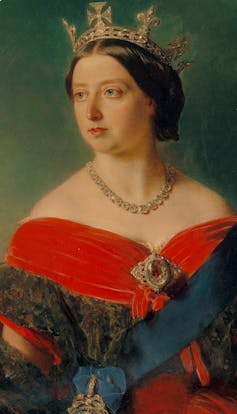The Tower of London’s Crown Jewel exhibition, which reopened in May, is a turning point in the museum’s narrative. As British institutions have increasingly made moves to investigate their connections to slavery, there has been a gradual acceptance of the complicated nature of the nation’s history, which does not sit comfortably in the binaries of good and bad, just and unjust or barbaric and kind.
The Crown Jewel exhibition showcases the effect of these changing narratives in its display of the Koh-i-noor and Cullinan diamonds.
Displayed as part of the museum’s larger collections of crowns, coronation regalia and other royal jewels dating from the middle ages, the two controversial diamonds are the key attractions of the exhibition. It explains how they originated in the colonies, travelled to Britain and were cut to be added to royal crowns.
The Koh-i-noor diamond has been the source of controversy for a long time, as south Asian nations, including India and Afghanistan, have demanded its reparation. This display marks the first time the Tower of London has explained the origins of the Koh-i-noor diamond, which is now presented as a “symbol of conquest”.
Because of its chequered path, mystery has surrounded the diamond for a long time and the exhibition attempts to dispel this, particularly the fact that the Koh-i-noor has sometimes been misrepresented as a gift.
The history of the Koh-i-noor
Mined in Golconda, India, the Koh-i-noor has had many possessors, ranging from Mughals and Persians to Afghans and Sikhs. In 1849, the East India Company took the diamond from the treasury of the defeated ten-year-old king maharaja Duleep Singh. He had become the emperor of the Sikh empire in the Punjab after the demise of his father, Maharaja Ranjit Singh.
The exhibition label now explains that “the 1849 Treaty of Lahore compelled 10-year-old Maharaja Duleep Singh to surrender it to Queen Victoria, along with control of the Punjab”.

When I asked why there is a changed emphasis on showing the origins of these diamonds, the lead curator told me that a pre-exhibition survey showed people’s appetite for knowing the origins and history of such objects.
The Cullinan diamond – the largest diamond ever to be found in South African mines – is presented as a purchase made by the colonial Transvaal government as a gift to King Edward VII, in 1907. The fragmented Cullinan, which was cut into nine pieces, has been used on various royalty insignia, ranging from the sceptre to crowns.
As it was featured in the recent coronation of King Charles, the diamond has come under renewed scrutiny, with talks of its origins being shrouded in British colonialism and the extraction of resources from colonies to the empire.
Beyond the diamonds
Despite this reframing, the story of colonialism and violence associated with these diamonds is never at the forefront of the exhibition. And so, the history of the child maharaja’s forceful separation from his mother, exile in Britain and death in Paris at the age of 55 is not explained.
However, the story of colonialism returns in the display of the Imperial Crown of India, which was made for King George V’s coronation as the Emperor of India in 1911.
Set with more than 6,000 diamonds, nine emeralds, four rubies and four sapphires, the Imperial Crown was made from Indian resources. Though the exhibition is about royal treasures, the memories, objects and the ghost of the British empire continue to live on in its collection.
Alongside the prized jewels of the royal family, are histories of ordinary people and minority groups in Britain’s imperial past. A section of the exhibition displays the dresses and objects of the guards of the Tower of London, who protect the crown jewels.
The dress of a soldier of the Gurkha Logistic Regiment tells the stories of subalterns in the royal world. Video screens show Britain’s diverse army with Asian and black soldiers who also took part in various past coronations. The story of these plebeians is actually the most exciting part of the exhibition, which is overshadowed by the shining jewels.

Looking for something good? Cut through the noise with a carefully curated selection of the latest releases, live events and exhibitions, straight to your inbox every fortnight, on Fridays. Launches August 4. Sign up here.
Arun Kumar does not work for, consult, own shares in or receive funding from any company or organisation that would benefit from this article, and has disclosed no relevant affiliations beyond their academic appointment.
This article was originally published on The Conversation. Read the original article.







